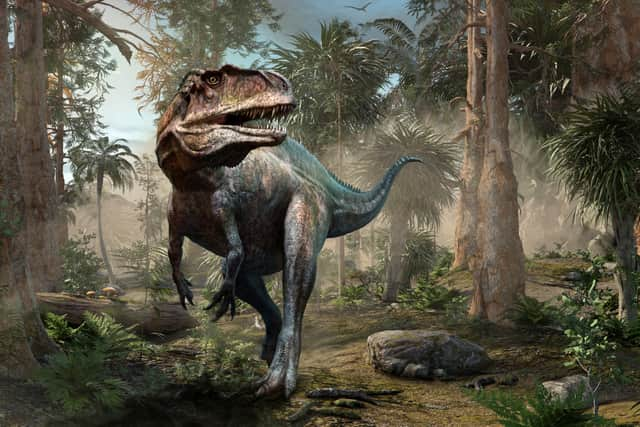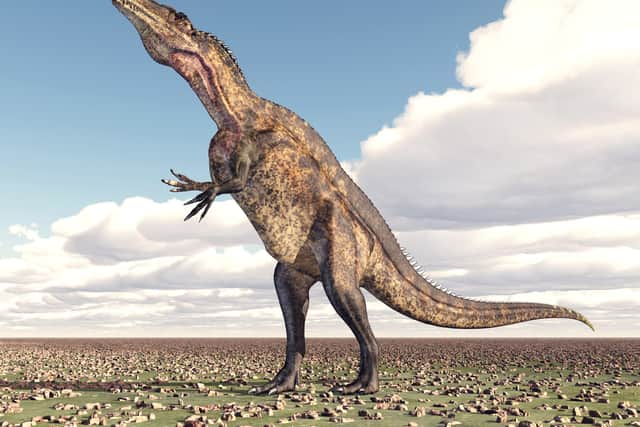Dinosaur Park footprints: how old are Acrocanthosaurus tracks, why were they discovered in Texas national park
and live on Freeview channel 276
Dinosaurs have not roamed the earth since they were wiped out in a major extinction event some 66 million years ago.
But we are still discovering evidence of them, with the most recent notable find being a well-preserved leg that was showcased in a BBC documentary with Sir David Attenborough.
Advertisement
Hide AdAdvertisement
Hide AdNow, experts in Texas have rediscovered remarkably intact footprints from an Acrocanthosaurus.
So, how old are the tracks - and what led to their rediscovery?


Here’s what you need to know.
What was an Acrocanthosaurus?
According to the Natural History Museum, the Acrocanthosaurus was a 12-metre (39-feet) long carnivorous dinosaur that lived between 115 million and 105 million years ago.
The dinosaur probably stood at twice the height of the average human.
Its fossils tend to be found in the USA and Canada.
Advertisement
Hide AdAdvertisement
Hide AdA predecessor to the Tyrannosaurus, which appeared some 50 million years afterwards, the creature is classified as a therapod - meaning it was a three-toed dinosaur.
Its name means ‘high-spined lizard’.


It is likely to have hunted the Sauroposeidon - a 44-tonnes long-necked herbivore that may have been able to grow to 34-metres (112-feet) long.
Its long neck and great height would have allowed it to feed on leaves at the top of trees, but the sheer size of the animal meant it would have been vulnerable to agile predators like the Acrocanthosaurus.
Its elephant-like tracks have been identified at the Texas national park where the Acrocanthosaurus footprints have been discovered.
How old are the dinosaur park footprints?
Advertisement
Hide AdAdvertisement
Hide AdA series of footprints belonging to one Acrocanthosaurus have been discovered in the Dinosaur Valley State Park, which is close to Fort Worth, Texas.
The US national park has been the site of several dinosaur footprint discoveries since the early 1900s.
It has been such a fertile ground for fossil hunters because a major flood in 1908 scoured away the riverbed of the Paluxy River, revealing ancient mud beneath.
The acrocanthosaurus tracks are 113 million years old.
This means they date from the Early Cretaceous period, which ran between 97.5 million years and 144 million years ago.
Advertisement
Hide AdAdvertisement
Hide AdKnown as the Lone Ranger trackway, the footprints go on for an unbroken 350ft (107 metres).
Why were the dinosaur park footprints found?
Usually, the Paluxy River covers up most of the footprints in the Dinosaur Valley State Park.
Even if the water levels are low, the tracks tend to be covered in a layer of mud and silt.
But with much of the US state of Texas experiencing a major drought, the river levels have dropped to little more than a trickle while the shoreline mud has almost completely dried up.
Advertisement
Hide AdAdvertisement
Hide AdIt means experts have been able to access the prints and clear them of debris.
Almost the entire state is experiencing what the US Drought Monitor describes as ‘severe drought’, with two-thirds of areas in ‘extreme drought’ and more than a quarter classified as being in ‘exceptional drought’.
This means farmers are likely to be losing their crops, farm animals are having to be culled and water quality becomes very poor.
It comes as the world battles a deepening climate crisis that has seen temperature records broken in the UK this summer.
Comment Guidelines
National World encourages reader discussion on our stories. User feedback, insights and back-and-forth exchanges add a rich layer of context to reporting. Please review our Community Guidelines before commenting.
